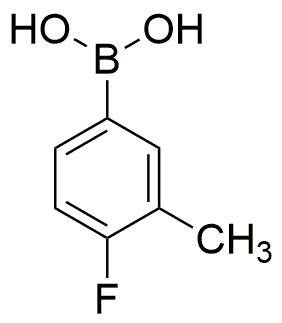4-Fluoro-3-methylphenylboronic acid is widely utilized in research focused on:
- Organic Synthesis: This compound serves as a key intermediate in the synthesis of various pharmaceuticals and agrochemicals, enabling the development of new drugs and crop protection agents.
- Catalysis: It is employed in Suzuki-Miyaura cross-coupling reactions, which are essential for forming carbon-carbon bonds in organic chemistry, making it invaluable for researchers in medicinal chemistry.
- Material Science: The compound is used in the development of advanced materials, including polymers and nanomaterials, which can enhance the properties of coatings and electronic devices.
- Bioconjugation: It plays a role in bioconjugation techniques, allowing for the attachment of biomolecules to surfaces or other molecules, which is crucial in drug delivery and diagnostic applications.
- Fluorine Chemistry: The presence of fluorine enhances the biological activity of compounds, making it a valuable tool in the design of new therapeutic agents with improved efficacy and selectivity.
Informations générales
Propriétés
Sécurité et réglementation
Applications
4-Fluoro-3-methylphenylboronic acid is widely utilized in research focused on:
- Organic Synthesis: This compound serves as a key intermediate in the synthesis of various pharmaceuticals and agrochemicals, enabling the development of new drugs and crop protection agents.
- Catalysis: It is employed in Suzuki-Miyaura cross-coupling reactions, which are essential for forming carbon-carbon bonds in organic chemistry, making it invaluable for researchers in medicinal chemistry.
- Material Science: The compound is used in the development of advanced materials, including polymers and nanomaterials, which can enhance the properties of coatings and electronic devices.
- Bioconjugation: It plays a role in bioconjugation techniques, allowing for the attachment of biomolecules to surfaces or other molecules, which is crucial in drug delivery and diagnostic applications.
- Fluorine Chemistry: The presence of fluorine enhances the biological activity of compounds, making it a valuable tool in the design of new therapeutic agents with improved efficacy and selectivity.
Documents
Fiches de données de sécurité (FDS)
La FDS fournit des informations de sécurité complètes sur la manipulation, le stockage et l’élimination du produit.
Spécifications du produit (PS)
Le PS fournit une description complète des propriétés du produit, notamment sa composition chimique, son état physique, sa pureté et les exigences de stockage. Il détaille également les plages de qualité acceptables et les applications prévues du produit.
Certificats d'analyse (COA)
Recherchez des certificats d'analyse (COA) en saisissant le numéro de lot du produit. Les numéros de lot et de lot se trouvent sur l'étiquette d'un produit, après les mots « Lot » ou « Lot de fabrication ».
Numéro de catalogue
Numéro de lot/série
Certificats d'origine (COO)
Ce certificat d'exploitation confirme le pays dans lequel le produit a été fabriqué, et détaille également les matériaux et composants utilisés et s'il est issu de sources naturelles, synthétiques ou autres sources spécifiques. Ce certificat peut être requis pour les douanes, le commerce et la conformité réglementaire.
Numéro de catalogue
Numéro de lot/série
Fiches de données de sécurité (FDS)
La FDS fournit des informations de sécurité complètes sur la manipulation, le stockage et l’élimination du produit.
DownloadSpécifications du produit (PS)
Le PS fournit une description complète des propriétés du produit, notamment sa composition chimique, son état physique, sa pureté et les exigences de stockage. Il détaille également les plages de qualité acceptables et les applications prévues du produit.
DownloadCertificats d'analyse (COA)
Recherchez des certificats d'analyse (COA) en saisissant le numéro de lot du produit. Les numéros de lot et de lot se trouvent sur l'étiquette d'un produit, après les mots « Lot » ou « Lot de fabrication ».
Numéro de catalogue
Numéro de lot/série
Certificats d'origine (COO)
Ce certificat d'exploitation confirme le pays dans lequel le produit a été fabriqué, et détaille également les matériaux et composants utilisés et s'il est issu de sources naturelles, synthétiques ou autres sources spécifiques. Ce certificat peut être requis pour les douanes, le commerce et la conformité réglementaire.


